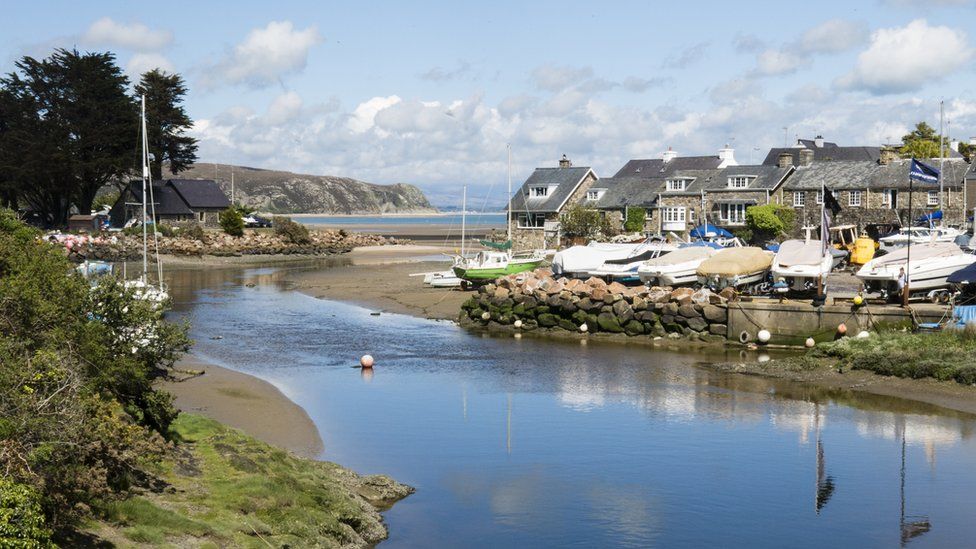Second homes: What are the issues in Wales?
- Published

Second homes are a contentious issue in Wales, following long-running rows over the effect they have in coastal areas.
There are 24,873 registered second homes and some people fear they are pricing out people from the area they grew up in, as well as threatening the Welsh-speaking culture.
Second home owners argue they feel like they are being "discriminated against" for buying homes in desirable areas.
So what factors are at play in the debate and what's being done?
How many second homes are there in Wales?
There were 24,873 second homes in Wales registered for council tax purposes in January 2021, according to official figures.
But the number could actually be much higher, depending on the exact definition of a second home, officials said.
This is because this number does not include holiday units, like AirBnbs and holiday lets, which are registered for businesses rates rather than those under second homes.
The Welsh government said Wales was the only UK nation to give councils discretionary powers to charge a council tax premium on long-term empty properties and second homes.
Those looking to buy second homes or buy-to-let properties have to pay an extra 4% in land transaction tax (LTT) on top of the tax payable for their band.
Which part of Wales has the most second homes?
Gwynedd has the highest number of second homes at 5,098 - 20% of all second homes in Wales - and one in every 10 houses in the county is now a second home.
This is followed by Pembrokeshire with 4,072 (9.15% of all homes), Anglesey with 2,112 (8.26%) and Ceredigion with 1,735 (5.91%) according to council and Welsh government figures for 2020.
In Llanengan, near Abersoch, in Gwynedd, 39.8% of all homes were second homes, according to figures from 2016.
Meanwhile, under the broader definition of second homes - to include holiday lets - these made up 46% of homes in Abersoch, 43% in Aberdyfi and 34% in Beddgelert.
The coastal village of Abersoch sees its population of 600 skyrocket to 30,000 in the summer months.
Figures from the Welsh Revenue Authority show 44% of all homes sold in the Gwynedd constituency of Dwyfor Meirionnydd in 2020-21 were subject to the higher rate of LTT.
Why do people have an issue with them?
Campaigners have been calling for action over growing concerns about rising house prices in seaside and rural communities, amid fears second home owners are pricing out locals.
The Welsh Housing Justice Charter campaign group said it regularly received calls from nurses, teachers, firefighters and those working on lifeboats who could not afford to live near where they work and volunteer.
Earlier this summer, hundreds of people in Gwynedd gathered to protest against Welsh government plans to "inject fairness back into the housing system".
One Welsh language campaign group, Cymdeithas yr Iaith, has called for measures, including new taxes and legislation, to bring in price caps on second homes.
People living in the small Pembrokeshire village Cwm-yr-Eglwys, where only two out of the 50 properties have permanent residents, said they feared their Welsh community could be lost forever.
However, second home owners said they feel "discriminated against" and called on councils to halt tax increases on second homes.
Some said they felt like they were shouldering the blame for what they labelled Welsh government failures on affordable homes.
Meanwhile, future generations commissioner Sophie Howe said she was concerned about how quickly any new powers to take action could take.
"If we don't act quickly, some of these communities will be damaged for a long time to come," she said.
What's being done about it?
This summer, Gwynedd council's leader called on the Welsh government to act, saying residents are "facing a situation where they cannot afford to buy a home within their local community".
In July, the Welsh government said it would pick an area to pilot new policies in an attempt to "inject fairness back into the housing system".
It said changes to taxes, government house purchase schemes and planning laws could be introduced.
Officials said they would also look at options to shut a tax loophole where some second home owners do not pay council tax - this is when second homes are designated as businesses, meaning owners pay business rates, rather than council tax.
Wales' climate change minister responsible for housing, Julie James, proposed three solutions in July:
- Addressing affordability and availability of housing
- Introducing regulations, including planning and the introduction of a statutory registration scheme for holiday accommodation
- Using national and local taxes to ensure second home owners "make a fair and effective contribution" to the communities where they buy
- NO LAUGHING MATTER : An attempt to solve the climate crisis using only the power of comedy
- BECAUSE HE'S ELECTRIC: Mike Bubbins' road-trip across Wales in an eco car, will the spark still be there?
- Published13 November 2021
- Published21 July 2021
- Published10 July 2021